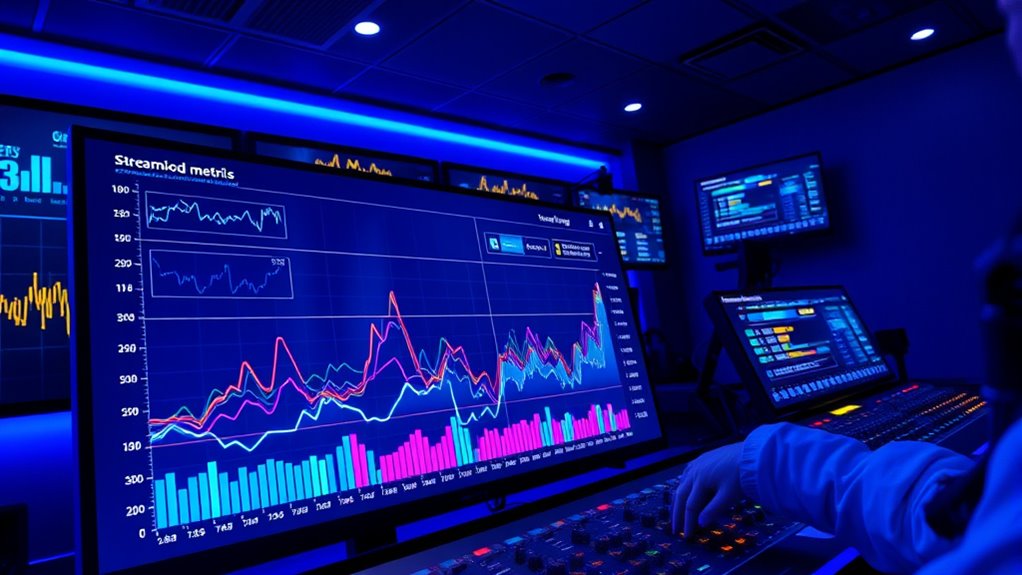Today, chart rankings combine digital streaming, sales, radio airplay, and social media buzz to reflect what listeners truly love. Streaming counts from platforms like Spotify and Apple Music are weighted to show popularity, while physical and digital sales still matter. Radio airplay and social media engagement influence a song’s visibility and momentum. These data are collected and updated in real time, making charts more dynamic. If you keep exploring, you’ll discover how these elements shape what hits the top.
Key Takeaways
- Chart rankings combine digital streaming, sales data, radio airplay, and fan votes to assess a song’s popularity.
- Streaming counts are weighted and aggregated from multiple platforms for real-time, accurate rankings.
- Physical album sales, especially vinyl, still influence charts alongside digital metrics.
- Social media engagement and influencer activity impact visibility and chart movement through trending content.
- Data collection involves automated tracking, cross-referencing sources, and regular audits to ensure ranking integrity.
The Foundations of Chart Rankings

Understanding the foundations of chart rankings requires recognizing how various metrics and data sources influence a song’s position. Today, charts consider more than just radio plays and sales; they also reflect trends like the vinyl resurgence, which shows how physical formats impact popularity. Fan voting is another key factor, allowing listeners to actively influence rankings through polls or online votes. These elements demonstrate that charts are not solely driven by commercial success but also by fan engagement and cultural shifts. By examining these metrics, you see how chart positions evolve, capturing both mainstream consumption and grassroots support. Recognizing the role of fan voting and physical format trends helps you understand the complex factors shaping modern chart rankings. Additionally, the integration of digital streaming data has become a crucial component in calculating chart positions today.
Sales Data and Physical Album Counts

Sales data and physical album counts continue to play a significant role in shaping chart rankings, especially as physical formats like vinyl and CDs experience a resurgence. The vinyl revival has led to increased sales, making physical albums a vital metric for chart calculations. While streaming dominates, chart compilers still track physical sales to reflect true popularity. Fan voting can influence sales figures, as dedicated fans often purchase physical copies to support their favorite artists. This loyalty boosts album counts and impacts rankings, especially during release weeks. Retail partnerships and exclusive editions also drive physical sales, further emphasizing their importance. Despite the growth of digital formats, physical album sales remain a crucial component in determining chart positions, representing a dedicated segment of dedicated collectors and fans committed to tangible music formats. Additionally, understanding Trailer Music Insights and Composition Techniques can inform how music impacts audience engagement, which in turn can influence sales and chart performance.
Digital Downloads and Streaming Metrics

You need to understand how streaming counts are weighted to reflect actual popularity accurately. Digital sales tracking guarantees that every purchase is counted correctly across platforms. Platform data integration combines these metrics seamlessly, giving a clear picture of an artist’s current chart standing. Additionally, dog names are often chosen to match an artist’s personality or branding, highlighting the importance of a memorable and fitting name.
Streaming Count Weighting
Have you ever wondered how streaming counts influence chart rankings today? Streaming count weighting plays an essential role in reflecting fan engagement and genre differentiation. The more streams a song receives, the higher its chart position, but not all streams are equal. Platforms often assign different values based on how fans interact with the music, such as repeat listens or playlist adds. Additionally, genre-specific algorithms can prioritize certain styles to guarantee diverse representation. This weighting system helps prevent popular songs from dominating solely through massive initial plays, giving room for emerging artists. It also balances mainstream and niche genres, maintaining fairness. Overall, streaming count weighting ensures charts accurately reflect active fan engagement across various musical landscapes. Incorporating listener behavior into the algorithms helps create a more nuanced and fair ranking system.
Digital Sales Tracking
Digital sales tracking combines data from digital downloads and streaming metrics to determine chart positions. Your fan engagement directly influences these numbers, as more dedicated listeners stream or purchase tracks, boosting chart ranks. Streaming platforms provide real-time data, making artist branding essential; the stronger your brand, the more fans engage online. Digital downloads, while less dominant than streaming now, still contribute to the overall picture, especially with exclusive content or bundles. These metrics reflect how well an artist connects with their audience and how effectively their brand resonates across digital platforms. Consistent engagement drives higher sales and streams, which in turn influences chart placement. Additionally, AI analytics are increasingly used to assess and predict audience behavior, further shaping chart success strategies. Ultimately, digital sales tracking emphasizes not just music quality but also your ability to cultivate a loyal, active fanbase online.
Platform Data Integration
Integrating data from digital downloads and streaming platforms creates an all-encompassing view of an artist’s digital performance. This process consolidates metrics from various sources, guaranteeing the charts reflect real-time fan engagement across different channels. Social media activity often influences streaming numbers, as viral trends can boost an artist’s visibility and rankings. Fan engagement, through playlist adds and shares, directly impacts streaming counts and chart positioning. To deepen this integration, data systems consider factors like:
- How social media buzz drives streaming spikes
- The role of playlist placements in boosting streams
- The influence of fan interactions on overall performance metrics
- The importance of essential oils in maintaining overall health and well-being, which can also influence an artist’s stamina and performance quality.
This holistic approach ensures chart rankings accurately mirror an artist’s current popularity and digital footprint.
Radio Airplay and Its Influence

Radio airplay still plays a vital role in shaping chart rankings today. You can see how radio play metrics directly influence airplay charts and overall visibility for artists. Understanding this impact helps explain why some songs climb quickly while others fade away. Additionally, Forsale 100 indicates the current demand and popularity for artists’ tracks, which can also influence radio stations’ decision to give certain songs more airplay.
Radio Play Metrics
Have you ever wondered how radio airplay influences a song’s chart position? Radio play metrics are essential, reflecting how often a song is broadcast on stations nationwide. This data is combined with audio streaming numbers and fan voting to determine a song’s popularity. Radio airplay boosts visibility, encouraging more streams and votes, which in turn elevate chart rankings. Stations may prioritize songs with high streaming numbers or active fan engagement, creating a feedback loop. Understanding this interplay helps you see how radio play impacts overall performance. To deepen your understanding:
- Radio airplay data is collected continuously from thousands of stations.
- Streaming platforms provide real-time listening figures that influence radio decisions.
- Fan voting can sway radio playlists, further impacting chart standings.
- Glycolic Acid promotes skin renewal and enhances the effectiveness of other skincare products, similar to how radio metrics can amplify a song’s reach and popularity.
Airplay Chart Impact
Radio airplay directly shapes a song’s position on the charts by increasing its exposure to listeners. When your track gets played across popular stations, it reaches diverse audience demographics, boosting its visibility and popularity. This wider exposure can lead to more streaming and sales, further improving its chart standing. Additionally, radio stations often partner with brands for collaborations, promoting songs through sponsored segments or events. These partnerships amplify airplay and help target specific listener groups, making the song more influential in chart calculations. Moreover, the integration of industry recognition as a key factor in provider selection can impact how stations choose which songs to promote, thus influencing chart rankings. Ultimately, consistent radio airplay not only elevates a song’s profile but also influences its ranking by leveraging audience engagement and strategic brand collaborations, solidifying its presence on the charts.
Incorporating Social Media Engagement

To effectively incorporate social media engagement into your chart rankings, you need to actively monitor and analyze audience interactions across platforms like Twitter, Instagram, and TikTok. Pay attention to viral challenges, hashtag campaigns, and trending content that boost a song’s visibility. These activities reflect genuine audience interest and can profoundly influence chart positions. Tracking the performance of hashtag campaigns helps identify which songs are gaining widespread attention. Additionally, engagement metrics such as shares, comments, and video creations give a clearer picture of a song’s popularity beyond traditional metrics. By combining data from these platforms, chart compilers can better gauge a song’s cultural relevance and virality. Recognizing the role of AI-powered data analytics can further enhance the accuracy of measuring social media impact. This approach ensures that social media buzz directly impacts your chart rankings, making them more reflective of current audience trends.
The Role of Playlist Curators and Influencers

Playlist curators and influencers wield significant power in shaping a song’s chart success by curating playlists and sharing content that boosts visibility. Your playlist influence can introduce tracks to new audiences and accelerate their popularity. When curators include a song in popular playlists, it often results in increased streams and discoverability, directly impacting chart rankings. Influencer collaborations amplify this effect, as influencers share videos or posts featuring the music, sparking viral trends and driving streams. These collaborations help artists reach targeted demographics and generate buzz quickly. As a result, playlist influence and influencer partnerships are now essential tools in the music industry, shaping how songs climb the charts and how quickly they can become hits. Your strategic use of these elements can make a significant difference.
Data Collection and Verification Processes

You rely on various data gathering techniques like streaming counts, sales figures, and social media metrics to compile chart rankings. Ensuring the accuracy of this data is vital, so validation methods such as cross-referencing sources and automated checks are used. These processes help maintain the integrity and reliability of the rankings you trust.
Data Gathering Techniques
Effective data gathering techniques are essential for ensuring accurate and reliable chart rankings. You need to collect data from diverse sources to capture true fan engagement and the impact of promotional campaigns. This involves monitoring streaming platforms, digital sales, and social media activity to gauge popularity. To add depth, consider these methods:
- Using algorithms that track streaming numbers and digital sales in real-time
- Analyzing social media mentions, shares, and hashtag usage to measure fan engagement
- Collaborating with digital platforms to verify data integrity and prevent manipulation
Accuracy Validation Methods
To guarantee the data collected from streaming platforms, sales reports, and social media accurately reflects true fan engagement, implementing rigorous validation processes is essential. You verify data integrity by cross-checking sources to detect and correct errors, reducing the impact of algorithm bias. Automated algorithms flag inconsistencies, ensuring the data isn’t skewed by manipulation or false activity. You also prioritize data privacy, safeguarding fan information during collection and analysis to maintain trust and comply with regulations. Regular audits help identify anomalies, and transparent reporting fosters accountability. By combining these methods, you ensure ranking calculations are fair, accurate, and resistant to bias, providing a true reflection of an artist’s popularity. This meticulous validation process upholds the chart’s credibility and reliability.
The Impact of Release Timing and Marketing Strategies

The timing of a release and the marketing strategies behind it can substantially influence a song’s chart success. Releasing at the right moment, like during peak streaming hours or avoiding competition, can boost visibility. Smart marketing strategies, such as teaser campaigns, influencer partnerships, and targeted ads, help generate buzz and drive initial streams. These tactics can create momentum that propels a song higher on the charts.
Timing and strategic marketing are key to boosting a song’s chart success and visibility.
To maximize impact, consider:
- Scheduling releases during strategic periods, such as holidays or weekends
- Coordinating marketing efforts across social media platforms and playlists
- Using data-driven insights to refine marketing strategies and timing decisions
How Real-Time Tracking Changes the Game

Real-time tracking has revolutionized how chart success is monitored and achieved. Now, you can see immediate data on audience demographics, revealing who’s listening and where they’re from. This instant feedback helps artists and labels adapt marketing strategies quickly, targeting specific regions or demographic groups to boost rankings. Regional differences are more evident, allowing for tailored campaigns that resonate locally. For example, if a song gains popularity in a particular city or country, streaming platforms reflect this instantly, giving artists a chance to capitalize on emerging trends. This dynamic process shifts power away from traditional release cycles, making chart positions more fluid and responsive to current listening habits. Ultimately, real-time tracking enables you to understand the evolving landscape of music consumption on a granular level.
Future Trends in Chart Calculation Methods

As technology advances, chart calculation methods are poised to become even more sophisticated and accurate. AI integration will allow for real-time data analysis, reducing delays and improving precision. User personalization will enable charts to reflect individual listening habits, offering more tailored rankings. Future methods might also incorporate emotional sentiment analysis, capturing listener engagement beyond just plays and streams. This evolution could lead to charts that are more dynamic and reflective of genuine popularity. Additionally, AI could identify emerging trends faster, giving new artists more visibility. As a result, your understanding of chart success will shift from raw numbers to a nuanced picture of listener interactions and preferences. These innovations promise to make chart rankings more responsive, personalized, and meaningful.
Frequently Asked Questions
How Do Chart Rankings Adjust for Regional Differences?
When it comes to chart rankings, you might wonder how they account for regional biases and market disparities. Today, they adjust by collecting data from various regions and weighting it based on market size and listener engagement. This means your favorite song’s position can reflect its popularity across different areas, balancing out regional differences so that larger markets don’t disproportionately influence the overall chart.
Can Artists Influence Their Chart Positions Through Social Media Campaigns?
Did you know that social media influence can critically boost an artist’s chart position? When you engage fans with creative campaigns, you drive more streams, shares, and downloads, directly impacting chart rankings. Fan engagement is essential—your team’s efforts can turn followers into active participants, pushing songs higher. So, yes, artists can strategically influence their chart positions through well-crafted social media campaigns, harnessing the power of their fan base to climb the charts.
What Measures Prevent Manipulation of Streaming and Sales Data?
You wonder how chart fraud is prevented. Billboard employs strict fraud detection measures and data validation processes to guarantee accuracy. They monitor streaming patterns and sales spikes for irregularities, flagging suspicious activity for review. Automated systems and manual checks work together to identify and eliminate manipulation attempts, safeguarding the integrity of chart rankings. This way, your favorite artists are fairly represented based on genuine popularity, not artificial boosts.
How Are Collaborations Between Artists Affected in Chart Calculations?
Think of collaborations like the “Friends” reunion—when artists team up, their combined efforts boost chart impact. The collaborative impact depends on how well artists’ fan bases merge and promote together, affecting streaming and sales. Artist partnerships can amplify chart success, but the system guarantees fairness by valuing individual contributions. Just like a vintage vinyl, collaborations bring unique value, enriching the overall chart landscape without unfair advantage.
Do Current Ranking Methods Account for Emerging Music Formats?
You’ll find that current ranking methods do account for the music format evolution, especially with digital distribution’s rise. Charts now track streaming, downloads, and even social media activity, reflecting how audiences engage across new formats. This approach guarantees your favorite tracks are evaluated fairly, regardless of whether they’re released through traditional or digital channels. So, as music formats evolve, chart calculations adapt to give an accurate picture of popularity.
Conclusion
As you now see how chart rankings are calculated, one thing remains certain: the game is always evolving. With real-time data and shifting social media trends, the next breakthrough could dramatically reshape how success is measured. Are you ready to follow these changes as they unfold? The secrets behind your favorite hits are more complex—and more fascinating—than ever. Keep watching, because what’s coming next could change everything you thought you knew.









